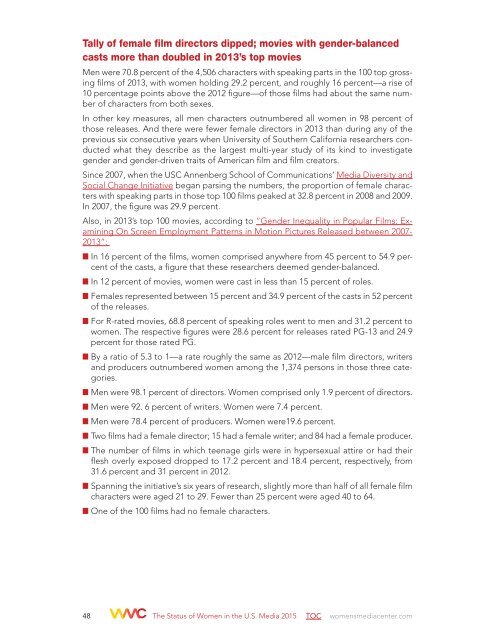THE STATUS OF WOMEN IN THE U.S MEDIA 2015
83bf6082a319460eb1_hsrm680x2
83bf6082a319460eb1_hsrm680x2
You also want an ePaper? Increase the reach of your titles
YUMPU automatically turns print PDFs into web optimized ePapers that Google loves.
Tally of female film directors dipped; movies with gender-balanced<br />
casts more than doubled in 2013’s top movies<br />
Men were 70.8 percent of the 4,506 characters with speaking parts in the 100 top grossing<br />
films of 2013, with women holding 29.2 percent, and roughly 16 percent—a rise of<br />
10 percentage points above the 2012 figure—of those films had about the same number<br />
of characters from both sexes.<br />
In other key measures, all men characters outnumbered all women in 98 percent of<br />
those releases. And there were fewer female directors in 2013 than during any of the<br />
previous six consecutive years when University of Southern California researchers conducted<br />
what they describe as the largest multi-year study of its kind to investigate<br />
gender and gender-driven traits of American film and film creators.<br />
Since 2007, when the USC Annenberg School of Communications’ Media Diversity and<br />
Social Change Initiative began parsing the numbers, the proportion of female characters<br />
with speaking parts in those top 100 films peaked at 32.8 percent in 2008 and 2009.<br />
In 2007, the figure was 29.9 percent.<br />
Also, in 2013’s top 100 movies, according to “Gender Inequality in Popular Films: Examining<br />
On Screen Employment Patterns in Motion Pictures Released between 2007-<br />
2013”:<br />
In 16 percent of the films, women comprised anywhere from 45 percent to 54.9 percent<br />
of the casts, a figure that these researchers deemed gender-balanced.<br />
In 12 percent of movies, women were cast in less than 15 percent of roles.<br />
Females represented between 15 percent and 34.9 percent of the casts in 52 percent<br />
of the releases.<br />
For R-rated movies, 68.8 percent of speaking roles went to men and 31.2 percent to<br />
women. The respective figures were 28.6 percent for releases rated PG-13 and 24.9<br />
percent for those rated PG.<br />
By a ratio of 5.3 to 1—a rate roughly the same as 2012—male film directors, writers<br />
and producers outnumbered women among the 1,374 persons in those three categories.<br />
Men were 98.1 percent of directors. Women comprised only 1.9 percent of directors.<br />
Men were 92. 6 percent of writers. Women were 7.4 percent.<br />
Men were 78.4 percent of producers. Women were19.6 percent.<br />
Two films had a female director; 15 had a female writer; and 84 had a female producer.<br />
The number of films in which teenage girls were in hypersexual attire or had their<br />
flesh overly exposed dropped to 17.2 percent and 18.4 percent, respectively, from<br />
31.6 percent and 31 percent in 2012.<br />
Spanning the initiative’s six years of research, slightly more than half of all female film<br />
characters were aged 21 to 29. Fewer than 25 percent were aged 40 to 64.<br />
One of the 100 films had no female characters.<br />
48<br />
<strong>WOMEN</strong>’S <strong>MEDIA</strong> CENTER<br />
The Status of Women in the U.S. Media <strong>2015</strong> TOC womensmediacenter.com


